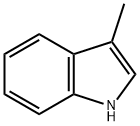| Chemical properties |
It is a kind of white crystal. The boiling point is 265-266 ° C; melting point is 93-96 ° C; soluble in 95% ethanol and oil spices three times of its volume. It has the indole-like incense of animals with a salty and strong flavor. The flavor is very strong, with a solid proliferating ability and a long lasting long time. High concentration of it makes people disgusting; only a very low concentration bears a large civet-like and animals-like incense. Moreover, It has a warm ripe fruit-like taste. |
| Uses |
1. 3-Methylindole has perfect fragrant value, often used as a fixative, but only used for the trace analysis of floral fragrance in comparison to large civet. It is also used to prepare large civet incense. A combination use with phenylacetic acid, cynomolone or giant ring ketone can get a fine natural animal fragrance. The ultimate trace analysis is used for grape, cheese, fruit, nuts and other fragrant flavor.
2. 3-methylindole has an unpleasant odor, while there is a pleasant fragrance after an enough dilution, especially the smell of civet-based incense. It will be effective in the cheese, nuts, grapes and other products by adding only a small amount. It can acquire a fish flavor when adding to seafood essence.
3. Used for organic synthesis reagents.
4. Used as a biochemical reagent with an inhibiting effect on trypsin. There is a floral fragrance after macrodilution. It is used in cigarettes, perfume in the fragrance, fragrance agent and food spices.
5. pharmaceutical intermediates; perfume fixative. |
| The standard of allowable maximum amount and residue |
Name of additives: β-methyl indole
Name of food allowable for the additive: food
Function of the additive:Spices used in food
Maximum allowable amount (g/kg):The amount of spices to compound essence should be lower than the allowable maximum amount and residue listed in GB 2760.
Maximum allowable residue (g/kg): |
| Production methods |
3-Methylindole present in civet, human, cheese, milk and tea. Propionaldehyde and phenylhydrazine can be heated to remove water molecules to obtain propanal phenylhydrazone in industrial production, and then the intermediates heated with zinc chloride or sulfuric acid, through the removal of ammonia molecules can obtain 3-Methylindole. |
| Chemical Properties |
slightly brown platelets |
| Uses |
insect attractant |
| Uses |
A naturally abundant pneumotoxin, found primarily in mammalian feces providing its strong fecal odor. In lower concentrations however, the compound has a pleasent aroma, giving orange blossoms and ja smine their pleasing scent. It is often a component of commercial fragrances and perfumes. |
| Uses |
A highly fluorescent guanosine analogue, which in a dimethoxytrityl, phosphoramidite protected form, can be site-specifically inserted into oligonucleotides through a 3?5?phosphodiester linkage using an automated DNA synthesizer |
| Definition |
ChEBI: A methylindole carrying a methyl substituent at position 3. It is produced during the anoxic metabolism of L-tryptophan in the mammalian digestive tract. |
| Safety Profile |
Poison by ingestion, intravenous, and intraperitoneal routes. Moderately toxic by subcutaneous route. When heated to decomposition it emits toxic fumes of NOx. |
| Purification Methods |
Crystallise skatole from *benzene or pet ether (m 96.5o). It has also been purified by zone melting. The picrate has m 182o (from Et2O or Et2O/MeOH). [Beilstein 20 III/IV 3206, 20/7 V 69.] |

 China
China





